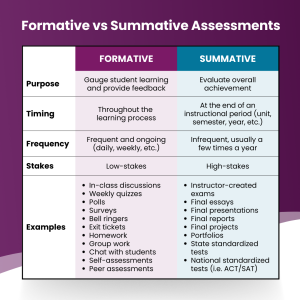Formative vs. Summative Assessments with Examples
The Difference Between Formative and Summative Assessments in the Classroom
Assessments are typically classified into two categories: formative and summative. Both play an essential role in evaluating and supporting students, but they serve different purposes and occur at different times. Understanding the differences between the two can help educators plan and implement assessments that align with their teaching goals and better support students.
What Is the Difference Between Formative and Summative Assessments?
Put simply, formative assessments are conducted throughout the instructional period to gauge student understanding and guide instruction. Summative assessments are given at the end of an instructional period to evaluate what students have learned. Let’s take a closer look at these assessment types, their purposes, and formative and summative assessment examples.

A Closer Look at Formative Assessments
The primary purpose of formative assessments is to provide continuous feedback throughout the instructional period. These assessments help identify areas of strength and weakness and allow educators and students to see where more practice is needed.
Formative assessments are low-stakes and designed to:
- Identify misconceptions, learning gaps, and areas of strength
- Guide instructional adjustments to meet student needs
- Encourage students to take ownership of their learning
Formative assessments are conducted frequently and informally. Teachers may use them daily or weekly, depending on the instructional goals and the pacing of the curriculum.
Teachers use a variety of tools and strategies for formative assessments, ranging from simple, quick activities to more structured approaches. Examples of formative assessment include:
- In-class discussions: Engage in open conversations with students to assess their understanding.
- Weekly quizzes: Check for understanding of recently covered material.
- Polls: Use quick, real-time polls to gather feedback on students’ opinions or understanding. Clickers are a great tool for this.
- Surveys: Use tools like Google Forms to collect more detailed feedback on student progress.
- Bell ringers: Start the class with a short activity to quickly evaluate students’ prior knowledge or what they remember from a previous lesson.
- Exit tickets: Ask students to complete a brief activity at the end of the class to assess their understanding of the day’s lesson.
- Homework: Assign practice exercises that reinforce what was covered in class and show how well students are getting it.
- Group work: Observe student collaboration and problem-solving to gauge their comprehension and teamwork.
- Chat with students: Have informal one-on-one or small group chats to assess how each student is doing.
- Self-assessments: Have students reflect on their learning and progress — like a quick one-minute writing assignment where they share what they’ve learned and any questions they still have.
- Peer assessments: Allow students to assess each other’s work. This is a great way to get students involved and motivated. Do a simple trade-and-grade or provide guiding questions or an unmarked rubric for more in-depth feedback.
For many educators, coming up with formative assessments every day or every week can be a time-consuming process. Tools like Progress Learning, however, make it easy. Our program allows teachers to easily create quizzes and assignments that are 100% aligned with their grade, subject, and standards. Many of our educators use Progress Learning for bell ringers and exit tickets. We also have a chat feature that makes it easy for teachers to check in with their students and see how they’re doing. By using Progress Learning, educators can create effective formative assessments, while saving time and energy.
A Closer Look at Summative Assessments
The main goal of summative assessments is to evaluate student learning at the end of an instructional period. These assessments provide a snapshot of overall achievement and are used to:
- Assign final grades or determine mastery
- Compare student performance to benchmarks or standards
- Measure the effectiveness of instructional strategies
Summative assessments are typically conducted at the end of a unit, semester, or academic year. They are more high-stakes than formative assessments and often require more comprehensive preparation. Pre-tests are sometimes given at the beginning of an instructional period so that teachers can compare the pre-test results with the summative assessment results and gauge progress over time.
Summative assessments are usually formal and structured. Common examples include:
- Instructor-created exams: These exams are designed to assess students’ knowledge and mastery of the material. They may include a mix of multiple choice, short answer, and essay questions.
- Final essays: These essays require students to analyze a topic, demonstrate research skills, and communicate their findings. They assess critical thinking, writing proficiency, and the ability to synthesize information.
- Final presentations: Students showcase their understanding of the material through oral presentations, often using slides or posters.
- Final reports: These reports assess students’ ability to organize information, apply research methods, and communicate effectively.
- Final projects: These projects require students to apply what they’ve learned throughout the class. They may involve research, creative work, or practical application.
- Portfolios: Portfolios are a collection of work that shows a student’s progress and achievements over time. It offers a comprehensive picture of their growth.
- State standardized tests: These assessments are used to measure how well students meet state academic standards. They provide data on individual and group performance and are often used to guide policy decisions.
- National standardized tests: These widely recognized tests, like the ACT and SAT, assess students’ readiness for college or career. They measure skills in areas like reading, writing, and math.
Similar to formative assessments, creating summative assessments can be a time-consuming process for educators and administrators. But Progress Learning takes that stress away. With our easy-to-use Assessment Builder, teachers and admin can easily go into the program, select their grade, subject, and standards, and create a summative assessment that is perfectly tailored to them. It’s also helpful for creating practice assessments that closely mirror the content, format, and testing experience of state and national standardized tests, like the SAT and ACT. With Progress Learning, teachers can save time, reduce stress, and create assessments that align perfectly with their instructional goals.
Creating Effective Formative and Summative Assessments
Although formative and summative assessments have different goals, occur at different times, and come in different forms, they are both essential for effective learning. Using them in the right way can help educators guide their instruction, identify areas for improvement, and keep their students on track.
Ready to easily create better and more effective formative and summative assessments? Request a demo of Progress Learning below to see how our custom assessment builder can help you.


